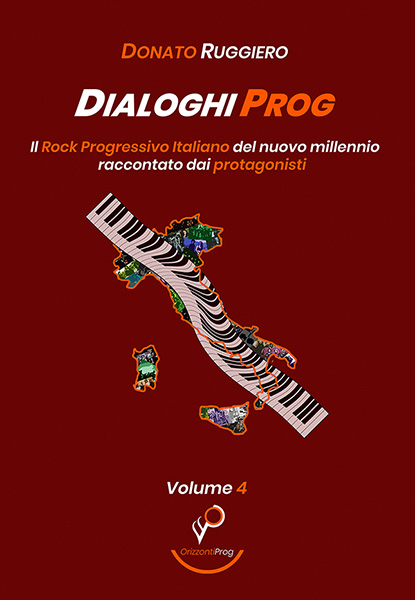Mourning Knight (2021)
Autoproduzione
Mourning Knight è un’entità musicale creata da Jason Brower durante gli anni ’90 per veicolare le proprie composizioni e le proprie poesie. Dopo aver registrato molte di queste creazioni con l’ausilio di un Tascam 8 tracce, l’artista statunitense, negli anni, è stato tentato più volte dal donare una veste professionale a tutte quelle demo ma… C’era un “ma”. E quel “ma” erano l’atmosfera e il mood di quel periodo, immortalati in quei nastri “amatoriali”, impossibili da ricreare con una nuova registrazione.
Di recente, però, qualcosa è intervenuto facendogli cambiare idea e, nel 2021, Brower ha pubblicato Mourning Knight. Cosa troviamo al suo interno? Le tracce di quel periodo, migliorate con ProTools grazie all’aggiunta di archi e cori di Mellotron, ma rese comunque il più vicino possibile agli originali. Per riuscire nell’intento, inoltre, Jason Brower (batteria, percussioni, tastiere, basso, voce) ha coinvolto anche Norm Dodge (chitarra elettrica e acustica, basso) e Alisa Amor (armonie vocali in Seance on a Wet Afternoon).
Andando oltre il dato tecnico-sentimentale, all’ascolto Mourning Knight si presenta come una “piccola storia” del progressive rock (e non solo) internazionale ben personalizzata, pieno di influenze (soprattutto seventies) ma da un riconoscibile tocco personale. E se tra i suoni policromi scorre soprattutto la passione e il dramma (ma ci sono anche molti momenti delicati), nelle parole trova spazio il lato più oscuro e malinconico della vita. E i testi sono davvero delle poesie, molto particolari e affascinanti (basta collegarsi alla pagina Bandcamp per assaporarne la qualità).
E anche l’artwork scelto per la copertina, il dipinto “Vanitas” di Adriaen van Utrecht, racchiude in qualche modo l’essenza “enciclopedica” del lavoro, in quella ricchezza di dettagli dipinta dall’artista fiammingo nella sua natura morta: fiori, monete, contenitori vitrei, un libro, un teschio e tanti altri piccoli elementi che, come perfetti tasselli, vanno ad incastrarsi l’un l’altro creando un’opera omogenea e armoniosa.
Unica pecca dell’opera, purtroppo, la qualità audio non eccelsa. Ma come si diceva poc’anzi, per scelta.
Seance on a Wet Afternoon. Il brano d’apertura ci accoglie caldamente, con un ottimo ordito di tastiere (a tratti oldfieldiane) e chitarre, prima che il solo alla Brian May di Dodge si impadronisca della scena. Con l’ingresso del canto di Brower, e grazie anche alle distorsioni, si piomba in territori Areknamés. Ciò che segue è un saliscendi emotivo con guizzi settantiani molto italiani, guidati dall’organo, e aperture luminose. Ma ci sono anche lampi beatlesiani e a là Eagles nella prima lunga parte di Seance on a Wet Afternoon, prima di spostarsi su di un fronte floydiano molto suggestivo e ben congegnato. E lo stacco ai 6.40 minuti è tipicamente nostrano (vedi Banco). Gran momento. Poi si riannodano i fili del canto, prima di un frammento evocativo, reso tale soprattutto dal vocalizzo etereo di Alisa Amor. E brillantemente scorrono via anche gli ultimi minuti del primo capitolo di Mourning Knight.
Molto delicata, a tratti struggente, Playing the Fool con quell’essenza molto intensa che si muove tra Alan Parsons Project, Pink Floyd e David Bowie. Da segnalare le gran belle prove di piano, batteria e chitarre, ben incastrate tra loro. […] You play the fool to empty aisles and to your knees you fall. / Soliloquies fill the shadows in the silent hall. / You use the masks to wear your smiles when tragedy befalls / bowing through the curtain to ghosts of old applause. / You bask in light of yesterday on the threshold of your disarray / as you fall through the arms of your departed. / You held the world within your hand, once a giant of the land / but now you’re cold and your skin hangs in the closet […].
Davvero fresca la partenza di Blood of Martyrs, quasi Lynyrd Skynyrd. Poi il quadro inizia a mutare sino ad uno stacco tenebroso, gobliniano. A seguire si veleggia su sponde canterburyane. Ma è un brano camaleontico, che vive di repentini cambi di rotta, tra oscurità e luce, tensione e distensione, con stacchi 100% prog che si muovono, tra gli altri, tra The Trip e King Crimson. Da brividi. Brano sorprendente.
Molto morbida e romantica The Blindman’s Window, con i leggeri tappeti d’archi ad avviluppare il canto passionale di Brower. Poi, gradualmente, strati si aggiungono a strati sino a raggiungere un ritmo tirato e rockeggiante (con sentori di Genesis “nell’aria”). In seguito tanto spazio agli assoli luminosi di chitarre, prima della “ripartenza”. There’s nothing left to see.
Anche Inside This Wonderland parte carica di dolce armonia (e un pizzico di essenza floydiana), con tanto di uccellini cinguettanti, poi si sviluppa sempre tenendo ben saldi i piedi su un suolo “non accidentato” ma ben caratterizzato nella sua indole sinfonica. Evocativa la stratificazione vocale che si sviluppa intorno ai 4 minuti e che lancia un nuovo momento “raccolto”, un dialogo voce/tastiere che cresce con l’aiuto del basso e di altri tasti sino ad esplodere. E si ricomincia, pacati, ma con diverso stato d’animo, leggermente più sofferente. Tutto è intenso e avanza senza ostacoli, con picchi emotivi quasi palpabili guidati dalle tastiere, un po’ Malibran, sino al denso finale. Miracles are for believers, illusions for deceivers.
Una lunga attesa. Ben ripagata.
ENGLISH VERSION
Mourning Knight (2021)
Self-production
Mourning Knight is a musical entity created by Jason Brower during the 90s to convey his compositions and poems. After recording many of these creations with the help of a Tascam 8-track, the American artist, over the years, has been tempted several times to give a professional look to all those demos but… There was a “but”. And that “but” was the atmosphere and the mood of that period, immortalised in those “amateur” tapes, impossible to recreate with a new recording.
Recently, however, something intervened to change his mind and, in 2021, Brower published Mourning Knight. What’s on the album? Tracks from that period, enhanced in Pro Tools through the addition of Mellotron strings and choir, but still as close to the originals as possible. Jason Brower (drums, percussion, keyboards, bass guitar, vocals) also involved Norm Dodge (electric and acoustic guitar, bass guitar) and Alisa Amor (harmony vocal on Seance on a Wet Afternoon).
Going beyond the technical-sentimental data, when listening to Mourning Knight, it appears as a “little story” of international progressive rock (and not only), well customized, full of influences (especially seventies) but with a recognizable personal touch. And while passion and drama flow mainly through the polychromatic sounds (but there are also many delicate moments), the darker and more melancholic side of life finds space in the words. And the lyrics are indeed poems, very particular and fascinating (just go to the Bandcamp page to feel the quality).
And also the artwork chosen for the cover, the painting “Vanitas” by Adriaen van Utrecht, somehow encloses the “encyclopaedic” essence of the work, in that profusion of details painted by the Flemish artist in his still life: flowers, coins, glass containers, a book, a skull and many other small elements that, like perfect pieces, fit together creating a homogeneous and harmonious work.
The only flaw in the work, unfortunately, is the poor audio quality. But as I said before, it’s a choice.
Seance on a Wet Afternoon. The opening track welcomes us warmly, with a fine warp of keyboards (sometimes Oldfieldish) and guitars, before Dodge’s Brian May-like solo takes over the scene. With Brower’s vocals, and thanks also to the distortions, we enter Areknamés territory. What follows is an emotional ups and downs, with very Italian seventies touches, led by the organ, and bright openings. But there are also flashes of Beatles and Eagles in the first long part of Seance on a Wet Afternoon, before moving to a very suggestive and well-thought-out Floydian front. And the break at 6.40 minutes is typically Italian (see Banco). Great moment. Then the threads of the song are knotted again, before an evocative fragment, made so especially by the ethereal vocalism of Alisa Amor. And the last minutes of the first chapter of Mourning Knight flow brilliantly.
Very delicate, at times poignant, Playing the Fool with that very intense essence that moves between Alan Parsons Project, Pink Floyd and David Bowie. The piano, drums and guitars are very well intertwined. […] You play the fool to empty aisles and to your knees you fall. / Soliloquies fill the shadows in the silent hall. / You use the masks to wear your smiles when tragedy befalls / bowing through the curtain to ghosts of old applause. / You bask in light of yesterday on the threshold of your disarray / as you fall through the arms of your departed. / You held the world within your hand, once a giant of the land / but now you’re cold and your skin hangs in the closet […].
The start of Blood of Martyrs is really chilly, almost Lynyrd Skynyrd-like. Then the “picture” starts to change until a dark, Goblinish break. Then we sail on Canterbury-like shores. But it’s a chameleonic track, living of sudden changes of path, between darkness and light, tension and relief, with 100% prog breaks that move between The Trip and King Crimson. Amazing. A surprising track.
Very soft, romantic, The Blindman’s Window, with light “carpets” of strings enveloping Brower’s intense singing. Then, gradually, layers and layers are added until reaching a fast, rockin’ rhythm (with hints of Genesis “in the air”). Then it’s time for some bright guitar solos, before the “restart”. There’s nothing left to see.
Inside This Wonderland also starts out full of sweet harmony (and a pinch of Floydian essence), with some chirping birds, then it develops, always keeping its feet firmly on “uneven” ground, but well characterized in its symphonic nature. The vocal layering that develops around 4 minutes is evocative and introduces a new “intimate” moment, a voice/keyboard dialogue that grows with the help of the bass and other keys until it explodes. And the song begins again, calm, but with a different mood, slightly more painful. Everything is intense and advances smoothly, with almost palpable emotional peaks guided by the keyboards, a bit Malibran, until the dense finale. Miracles are for believers, illusions for deceivers.
A long wait. Well repaid.










Lascia un commento